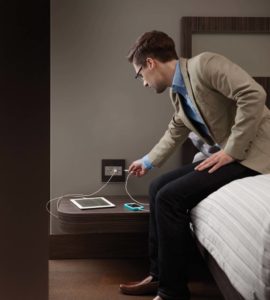Specifying electrical products for hotel properties
by Nancy Snyder

All photos courtesy Legrand
Hotel guests are more technology-focused than ever before. This has created a hyper-connected travel experience, from ordering transportation to the check-in process. So what do architects and specifiers need to keep in mind when working on hospitality projects?
According to a survey conducted by Expedia, 75 percent of travelers use smartphones and tablets for both personal and business reasons when traveling. Mobile devices are nearing ubiquity for business travelers across all regions and demographics, but more so for millennials than any other group, unsurprisingly.
This means travelers require convenient and easy access to power when it is needed most. Devices play a huge role in the travel experience, from research and booking to in-room services and check-in/check-out. As such, hospitality designers, owners, and operators must ensure power solutions are readily available for guests and feel seamless in the overall design. Intuitive, rather than disruptive, design is crucial.
Increase power access and connection points
There are many opportunities to improve the guest experience by helping hotel owners and developers remain ahead of power-based trends and needs. Architects, designers, and specifiers must stay in the know about the consumer technology industry and be sure to:
- offer power access via USB ports in addition to (or rather than) traditional alternating current (AC) power outlets;
- ensure multiple devices can be plugged into one source so as to save space, offer a clean aesthetic, and fully charge at the same time;
- remember each device has its own specific charging needs;
- ensure power access is flexible, universal, and accessible to accommodate unique needs without limiting others;
- avoid builder-grade power outlets and light switches and replace with chic, elevated designs;
- opt for built-in furniture options enabling power built into headboards and other areas;
- bring power/control where it is used most while eliminating extra wiring; and
- be familiar with national/local electrical codes, such as National Electric Code (NEC).
When it comes to guest rooms, architects and specifiers should see the space’s features—including the TV armoire, desks, walls, headboards, and bedside tables—as opportunities for power, charging, switching, dimming, and connectivity.
Utilize common spaces to create opportunities
In the past, hotel rooms offered in-room desks, as it was expected that people worked in their rooms. Now that rooms are growing smaller, travelers want to work in more social settings.

As hospitality businesses begin to re-evaluate the way they approach guest experiences, common spaces offer a new area of opportunity. Spaces to work, socialize, or relax outside of the guest room have become more desirable among hotel guests—especially millennial travelers. In fact, 36 percent of millennials prefer to work in the lobby area, compared to 17 percent of older generations. More and more hotel lobbies are being designed as an attractive place for work with a social component, adapting to the changing needs of younger travelers. After all, what good is offering free Wi-Fi throughout a property if guests have nowhere to plug in and charge?
It is important to consider how guests will use common areas, incorporating varied seating arrangements accommodating different working styles. Integrating power access into furniture pieces or flooring treatments is also crucial. One should remember to make access easy without being a visual distraction, regardless of location.
As the lines between hotel lobbies, bars/restaurants, and business centers blur, offering solutions to multiple needs—power, food, and productivity—encourages guests to enjoy a coffee or meal while plugging in and connecting. These needs should be met throughout the property, with power and charging offered in lobby furniture, restaurants and bars, and meeting and outdoor spaces, along with additional connectivity capabilities in meeting areas.






